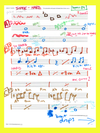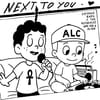Presenting an Extremely Detailed, Color-Coded Score for Sophie’s “Hard”
A playful new transcription of the 2014 song by a music professor gives us a fresh way of thinking about how the revolutionary electronic producer composed her work.

This graphic score for Sophie’s minimalist heart explosion “Hard” came to us via Katie Battistoni, a friend of Hearing Things, musician (as Katy the Kyng), and professor at Manhattan’s New School. Battistoni transcribed the track for a class on avant-garde songwriting, and I was immediately compelled—not just because her score is as beautiful and chaotic as the track, but because it’s so rare to see sheet music for a piece of contemporary electronic pop music.
Battistoni created this in the tradition of midcentury Dadaists and experimental composers like John Cage and Anthony Braxton, the latter of whom scores his music with as much vibrant color (and interpretive squiggle) as she uses here. The key at the beginning represents each instrument in the score—the “sparklepiano,” for instance, is represented by star-dotted notes in shimmering gold Sharpie. “The avant-garde parts of this song are the characters, which are the instruments Sophie has invented,” Battistoni told me, “so I wanted them to have all their little identities, like characters in a play.”





